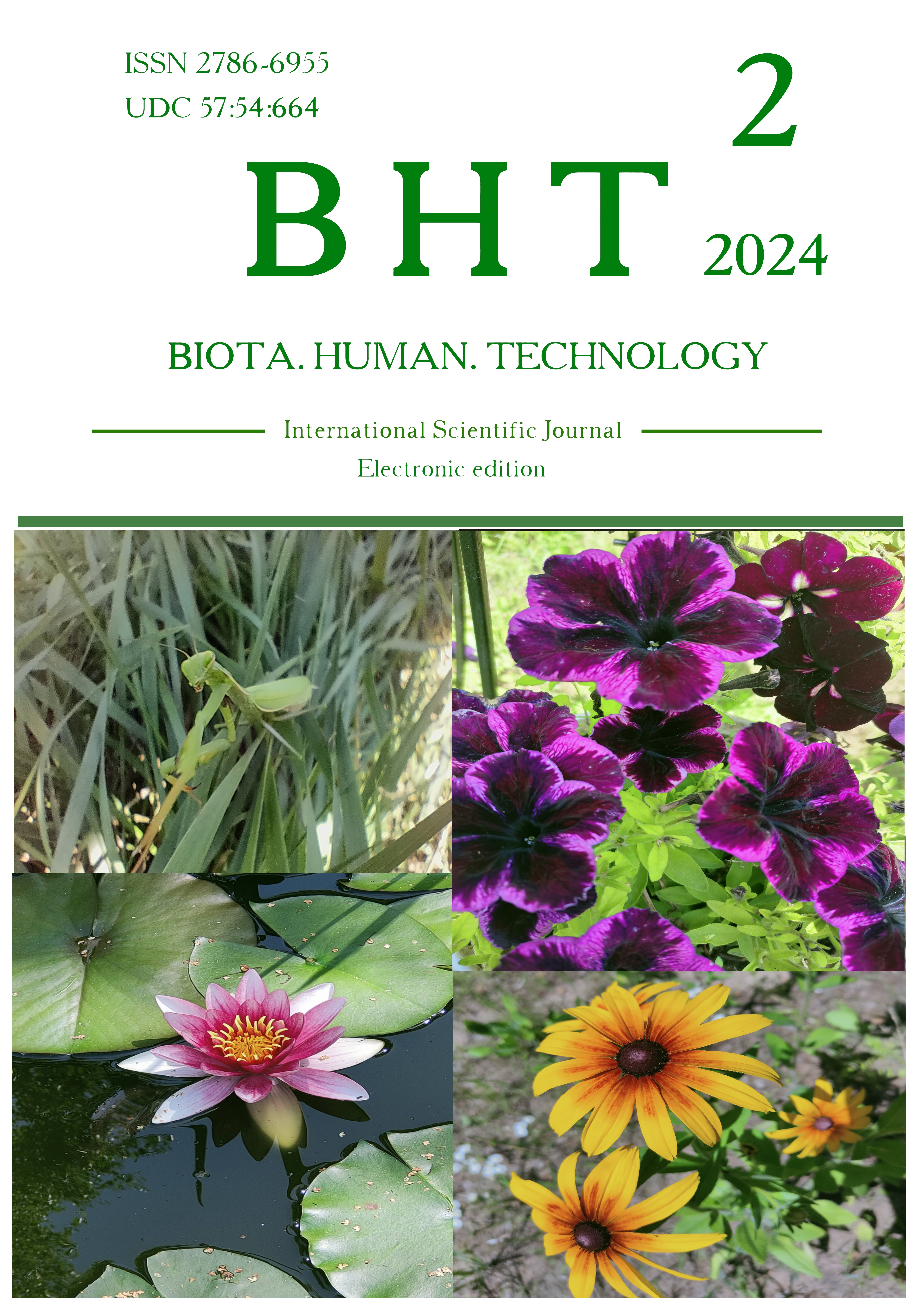INTEGRATION OF BIOTECHNOLOGY INTO THE CIRCULAR ECONOMY
DOI:
https://doi.org/10.58407/bht.2.24.8Keywords:
biotechnology, circular economy, linear economy, nonlinear economy, bioremediation, biosynthesis, biodegradation, bio-processing, bioengineeringAbstract
Objective. The article emphasises the importance of the study because of the effectiveness and representativeness of the integration of biotechnology into the circular economy, as it provides a non-linear approach that promotes additional profits and protects the environment from environmental disasters.
Methodology. The methods used include: a) biodegradation and biodecomposition using biomaterials such as organic waste, biopolymers and bioplastics, which are studied using biochemical tests, mass spectrometry and molecular biological methods; b) biosynthesis and biorefining using living organisms such as bacteria, fungi and algae, which are genetically modified to increase their productivity and sustainability; c) bioremediation for the study of biomaterials and microorganisms that clean up contaminated sites, using high-performance liquid chromatography and molecular genetic methods to assess efficacy and environmental safety; d) bioengineering, which includes high-throughput genome editing methods.
Scientific novelty. The core principles of the circular economy include renewability (repair and reuse of products), differentiation (selection of materials whose decomposition is faster and safer), environmentalism (use of clean energy sources that increase the sustainability of systems) and culturalism (spreading the environmental paradigm to change consumer behaviour).
Conclusions. The integration of biotechnology into the circular economy is of particular importance in the context of the current environmental situation and the need to introduce a non-linear economy that meets the modern culture of consumption. The main prospects are the improvement of existing methods, innovative solutions and interdisciplinary approaches. Further research should focus on improving biodegradation processes and introducing new materials, which will help to intensify interaction between academic institutions, industrial companies and other stakeholders. Biotechnology in the context of the circular economy has significant potential for sustainable development, environmental protection, and intensification of scientific progress through the development of new methodologies, techniques, and integrative research projects.
Downloads
References
Abdullah, M. A., Nazir, M. S., Hussein, H. A., Shah, S. M. U., Azra, N., Iftikhar, R., ... & Hung, Y. T. (2024). New perspectives on biomass conversion and circular economy based on Integrated Algal-Oil Palm Biorefinery framework for sustainable energy and bioproducts co-generation. Industrial Crops and Products, 213, 118452. https://doi.org/10.1016/j.indcrop.2024.118452.
Begum, S., Juntupally, S., Arelli, V., & Anupoju, G. R. (2024). Waste to biomethane: advent of circular economy. In Biogas to Biomethane (pp. 225–242). Woodhead Publishing. https://doi.org/10.1016/B978-0-443-18479-6.00007-7.
Circular economy model. (2024). Diya Business: website. Retrieved May 06, 2024, from https://goo.su/SqcR (in Ukrainian)
Модель циркулярної економіки. (2024). Дія Бізнес : вебсайт. URL: https://goo.su/SqcR (дата звернення: 06.05.24).
Duong Thi Binh, A., Akbari, M., Le Thi Cam, H., Nguyen Canh, L., & Truong Quang, H. (2024). Forging Pathways to Circular Economy Excellence: Integrating Industry 4.0 with Quality Management. Sustainability, 16(7), 3053. https://doi.org/10.3390/su16073053.
Jaroenkietkajorn, U., Gheewala, S. H., Mungkung, R., Jakrawatana, N., Silalertruksa, T., Lecksiwilai, N., ... & Nilsalab, P. (2024). Challenges and Opportunities of Bio-Circular-Green Economy for Agriculture. Circular Economy and Sustainability, P. 1–22. https://doi.org/10.1007/s43615-024-00355-9.
Montalvo-Romero, N., Montiel-Rosales, A., Sandoval-Herazo, L. C., & Purroy-Vásquez, R. (2024). Bioremediation of Wastewater from the Tanning Industry Under a Circular Economy Model. In Nature-based Solutions for Circular Management of Urban Water (pp. 169–184). Springer International Publishing. https://doi.org/10.1007/978-3-031-50725-0_10.
Moreroa, M., Malematja, T. P., & Ijoma, G. N. (2024). Integrating the circular economy model into the management and treatment of Fischer-Tropsch effluents-a conversion of waste to energy (biogas) opportunity. IET Renewable Power Generation. https://doi.org/10.1049/rpg2.12976.
O’Boyle, M., Mohamed, B. A., & Li, L. Y. (2024). Co-pyrolysis of sewage sludge and biomass waste into biofuels and biochar: A comprehensive feasibility study using a circular economy approach. Chemosphere, 350, 141074. https://doi.org/10.1016/j.chemosphere.2023.141074.
Preethi, B., Karmegam, N., Manikandan, S., Vickram, S., Subbaiya, R., Rajeshkumar, S., ... & Govarthanan, M. (2024). Nanotechnology-powered innovations for agricultural and food waste valorization: A critical appraisal in the context of circular economy implementation in developing nations. Process Safety and Environmental Protection. https://doi.org/10.1016/j.psep.2024.01.100.
Singh, R. P., Yadav, P., Kumar, I., Kumar, A., & Gupta, R. K. (2024). Precision biotechnology using beneficial microbes as a fundamental approach to the circular economy. In The Potential of Microbes for a Circular Economy (pp. 73–103). Academic Press. https://doi.org/10.1016/B978-0-443-15924-4.00001-1.
Sobral, L. G. S., de Aguiar Sobral, L., de Oliveira, A. D. N., Silva, I. G., & de Araujo, P. C. (2024). Mineral-Metal Wastes (Bio)/Recycling: Compliance with Circular Economy. Biotechnological Innovations in the Mineral-Metal Industry, P. 229–244. https://doi.org/10.1007/978-3-031-43625-3_13.
Trivedi, R., Upadhyay, T. K., Khan, F., Pandey, P., Kaushal, R. S., Sonkar, M., ... & Siddique, M. A. B. (2024). Innovative strategies to manage polluted aquatic ecosystem and agri-food waste for circular economy. Environmental Nanotechnology, Monitoring & Management, 100928. https://doi.org/10.1016/j.enmm.2024.100928.
Downloads
Published
How to Cite
Issue
Section
License
Copyright (c) 2024 Володимир Єрохін , Максим Стець

This work is licensed under a Creative Commons Attribution 4.0 International License.


